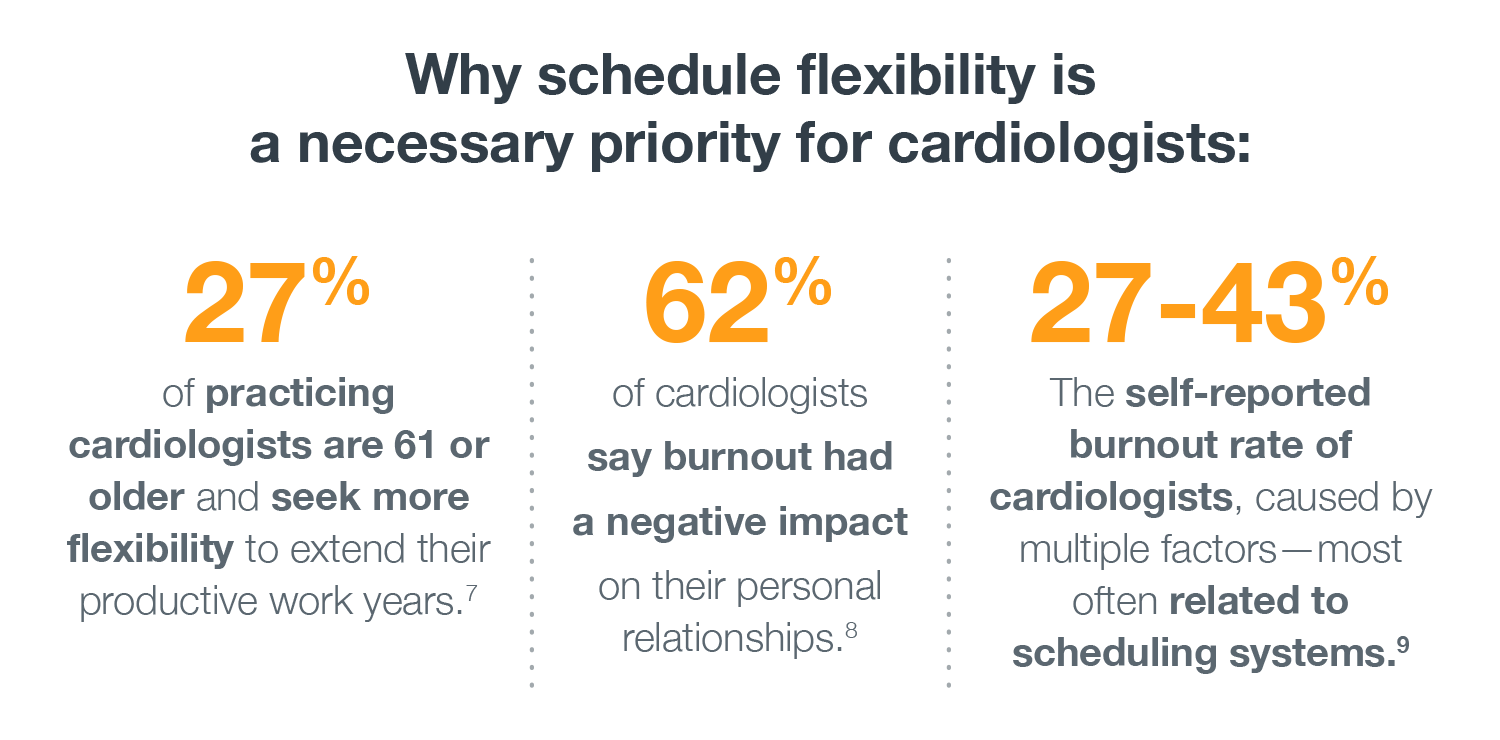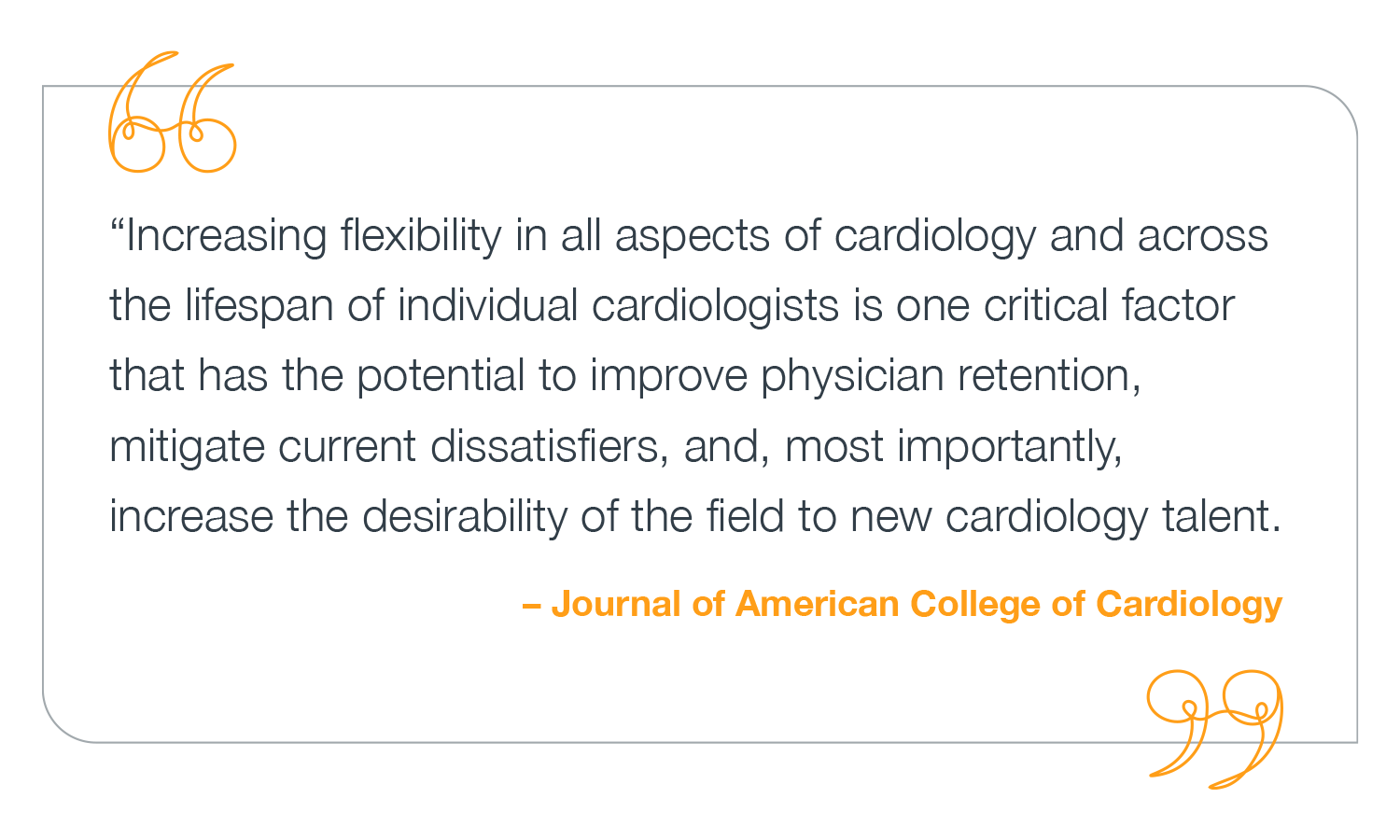Live Event
Real solutions from experts who've moved the needle on burnout
Register NowTABLE OF CONTENTS
The best clinical workplaces are the result of strategies and practices aimed at optimizing things like organizational workflows (i.e., the day-to-day activities involved in delivering patient care), communication efficiencies, and provider satisfaction. Ideally, these practices should also give providers the flexibility and autonomy they deserve, but in a way that doesn’t impede them from meeting their organizational goals and requirements. Cardiology is a good example of a specialty that comes with a number of unique needs that must be accounted for to support an optimal workplace environment. We’ll take a closer look at these needs below as we address the overarching importance of flexibility for cardiology practices.
To discuss workforce flexibility and its effects on workplace optimization, we first need to define “flexibility.” In this instance, workplace flexibility refers to the innate variability of schedules and the ability of the people and systems that create them to adapt to different circumstances. This means that regular scheduling hours—such as the standard work schedule—and alternative scheduling hours—like flexible time off, shift swaps, and breaks—need to be built with flexible scheduling rules that can be adjusted to meet the needs of the moment.
According to the Journal of the American College of Cardiology (JACC), career flexibility is a critical component of a thriving workforce and is achieved by enabling providers to maintain a healthy work-life balance while meeting personal, professional, and organizational needs.1 The JACC also states that “all cardiologists should have access to flexibility in hours and work commitments according to personal needs, preferences, and expertise, while being mindful of patient, program, team, and institutional needs.” Because these factors have a direct impact on things like career progress and compensation,2 they can also affect provider satisfaction and the overall optimization of cardiovascular care.
Like much of the healthcare workforce, cardiologists often have to deal with a lot of stress. Cardiologists also work more hours annually than many other medical specialties, which can contribute to higher levels of burnout.3 Over the past two decades, the composition of the cardiology workforce has changed, and expectations have evolved as well. These changes have resulted in increased pressure for many cardiologists.4 Some of these demands include the increasingly 24/7 nature of cardiovascular care (CV), intensifying patient complexity, and new procedures and innovation in techniques.5 These advances—among other factors—have led to increased interest in creating more flexible schedules for cardiologists to improve job retention, increase career longevity, and improve diversity.6

The field of cardiology has more complex scheduling requirements than other medical specialties for a number of reasons. In particular, opportunities for stable work hours are less frequent in the clinical practice of some cardiology subspecialties,10 as protocols for responding to certain calls in CV events vary drastically. When one patient is being monitored after a CV event, their outcome—and therefore the time it takes to address and treat their symptoms—can vary to a greater extent than a more predictable case, such as a patient coming in for a follow-up appointment. Any of these conditions can necessitate immediate surgical intervention, so schedules must be adaptable as a physician administers care in each case. And because cardiologists receive a high number of consult requests across multiple inpatient and outpatient facilities, schedules must be built to account for the time it takes to get to each practice and the time it will take to transition between appointments before and after a change in location. The combination of these circumstances makes it difficult to schedule providers with a predictable, standardized schedule.
It’s important to note that fatigue from working a busy shift can (and does) affect physician well-being and the quality of patient care. The ACC says one possible solution for adhering to more standardized scheduling protocols—and also creating a more streamlined process for flexing that schedule as needed—lies in instituting a “maximum consecutive hours worked” policy so that providers can rest after a long day of consultations rather than working a subsequent surgery or appointment. Other practices may opt for shift work, where call types dictate what clinical responsibilities a provider will or will not work during that same block of shifts. For example, if a provider works four consecutive overnight shifts, they will not have any scheduled clinical responsibilities during those four days. Other suggestions include shifting to a hospitalist model rather than combining office and hospital coverage in practice.11

As we’ve seen, a lack of workplace and scheduling flexibility greatly diminishes career satisfaction and increases feelings of burnout—things that are not unique to the cardiology field. The very nature of CV care creates the need for structured flexibility, and with the right scheduling solution and best practices in place, CV care is optimized for both patient and provider. Better, more flexible scheduling and an easier schedule creation process lays the foundation for more flexible working hours. Offering autonomy over schedules is not only beneficial to the recruitment and retention of cardiologists, but also shows that physician burnout and job stress can be alleviated when flexible work roles and schedules are implemented.12 By empowering providers to reduce work hours when needed, swap available shifts, convert applicable appointments to telehealth, and transition to part-time work when necessary, they are more likely to stay in the cardiology field.13
The Journal of the American College of Cardiology recommends many best practices for building career and workplace flexibility into cardiology practices. It reiterates that cardiologists should have access to flexibility in hours and work commitments that account for both personal and professional needs. It also recommends that predetermined and transparent policies must support increased flexibility. Most importantly, the ACC states that “flexibility in hours and work commitments will assist all cardiologists with providing value across their career lifespan.”
We’ll end with two eye-opening stats: 58% of cardiologists said they would take a salary reduction if it meant they could achieve a better work-life balance, which was slightly more than the 55% of physicians who would be willing to sacrifice pay for more personal time.14 It should go without saying, but cardiologists shouldn’t be forced to take a pay cut to have an acceptable work-life balance.
Learn how Lightning Bolt Scheduling can optimize the provider scheduling process to build more flexibility and autonomy into the daily lives of your cardiologists.
Sources
1-6 A Report of the American College of Cardiology Solution Set Oversight Committee, Journal of The American College of Cardiology: https://www.jacc.org/doi/10.1016/j.jacc.2022.08.748?_ga=2.87499472.912240672.1673631464-1855396229.1671563388#bib39R
7 2019 Cardiovascular Provider Compensation & Production Survey, MedAxiom: MedAxiom.com/CompSurvey as cited in A Report of the American College of Cardiology Solution Set Oversight Committee, Journal of The American College of Cardiology.
8,14 8 Surprising Facts About Cardiologist Burnout, Healthgrades: https://www.healthgrades.com/pro/8-surprising-facts-about-cardiologist-burnout#:~:text=Cardiologists%20are%20in%20the%20middle,%25
9 Cardiologist lifestyle, happiness and burnout report 2019, Medscape, Kane L.,February 20, 2019: https://www.medscape.com/slideshow/2019-lifestyle-cardiologist-6011085 as cited in Provider Compensation & Production Survey, MedAxiom: MedAxiom.com/CompSurvey as cited in A Report of the American College of Cardiology Solution Set Oversight Committee, Journal of The American College of Cardiology.
10, 11 A Report of the American College of Cardiology Solution Set Oversight Committee, Journal of The American College of Cardiology: https://www.jacc.org/doi/10.1016/j.jacc.2022.08.748?_ga=2.87499472.912240672.1673631464-1855396229.1671563388#bib39R
12,13 Does a Flexibility/Support Organizational Initiative Improve High-Tech Employees’ Well-Being? American Sociological Review, Sage Journals: https://journals.sagepub.com/doi/10.1177/0003122415622391